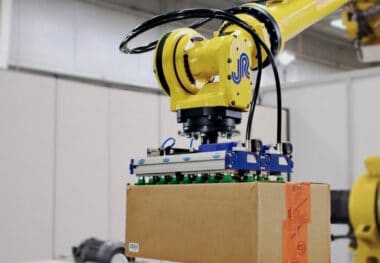Harnessing Next-Generation Warehouse Robotics
Advances in robotics and AI are driving innovation in warehouse automation.

A radical shift in consumer behavior accelerated by the COVID-19 pandemic has exponentially expanded the wide-scale adoption of e-commerce and online purchasing. As consumers increasingly make online purchases for standard items like groceries and household supplies, this shift is likely to become permanent ― creating a significant impact on warehouse operations and creating new opportunities for innovation.
Early winners so far in this business environment have been the technology-embracing early adopters such as Amazon and Ocado, who have innovated with robotics and software to create more efficient, durable supply chains. However, there’s room in this space for all players who are prepared to adopt warehouse automation and robotics. It’s likely that those who don’t participate in this disruptive innovation risk being left behind.
Adapting to Warehouse Challenges
Traditionally, robotics has been applied in repeatable, fixtured applications such as those on automotive assembly lines. Now, artificial intelligence (AI) and the Internet of Things (IoT) are enabling breakthroughs in robotic perception and complex decision-making in real time. This allows robotic technologies to operate effectively in more complicated, unstructured environments such as the warehouse and distribution networks.
 Due to the inherent modularity and scalability of robotics systems for picking, sorting, and palletizing, organizations of all sizes can reap the benefits of these innovations while making warehouse operations more efficient, cost-effective and safe. The ability to add solutions with a high return ROI, intermixed with manual processes, make them ideal candidates for investment in existing manual facilities.
Due to the inherent modularity and scalability of robotics systems for picking, sorting, and palletizing, organizations of all sizes can reap the benefits of these innovations while making warehouse operations more efficient, cost-effective and safe. The ability to add solutions with a high return ROI, intermixed with manual processes, make them ideal candidates for investment in existing manual facilities.
The Robotics Opportunity
The rise of e-commerce has stressed existing parcel and distribution networks to their limits. Faced with a huge need for the efficiencies and increased capacity that warehouse automation can fill, a new breed of intelligent robotics solutions has started to go mainstream. The scalability of these solutions makes them a good fit for an industry that is still mostly manual, and they are a logical next step. For many enterprises, warehouse automation adoption is lagging significantly or absent altogether. According to DHL research, 80% of warehouses remain manually operated. Another recent survey indicates that the greatest investments to date are in conveyance (63%), while robotic palletizing and picking are still very low (15% and 8%, respectively).
Major e-commerce companies know that nimble, automated supply chains are key to meeting demand and staying ahead of the competition. To keep up with these major players, smaller and emerging e-commerce companies must take the right steps to automate their warehouse supply chains too.
Every Season is Peak Season
Prior to the pandemic, e-commerce and logistics were geared toward the peak season (early November through January). Distribution networks would ramp up for peak, then struggle with underutilized capacity for the remaining nine months. In 2020, the peak began in mid-March and hasn’t slowed. The challenge now for many smaller enterprises is how to innovate and grow within a peak environment that never subsides. Enterprises no longer have the luxury of a downtime during which to upgrade facilities to increase capacity and integrate new technology.

The e-commerce giants have an easier time integrating new technology organically because their technology stacks are already built. Smaller enterprises must work to bridge this chasm. One of the advantages of advanced robotics is that it can be integrated into operations without taking down a system or facility. Robotics can be added little by little, in a modular fashion, without major disruptions.
The Holistic Approach
There is now a significant need among both types of businesses to explore the best ways to develop, productize, and scale solutions across their entire distribution networks. By adopting a customized holistic solution that addresses key challenges and provides insights across their IT and warehousing infrastructures, companies now have an opportunity to drive continuous improvements and create flexible, robust supply chains that can keep up with increasing customer demands.